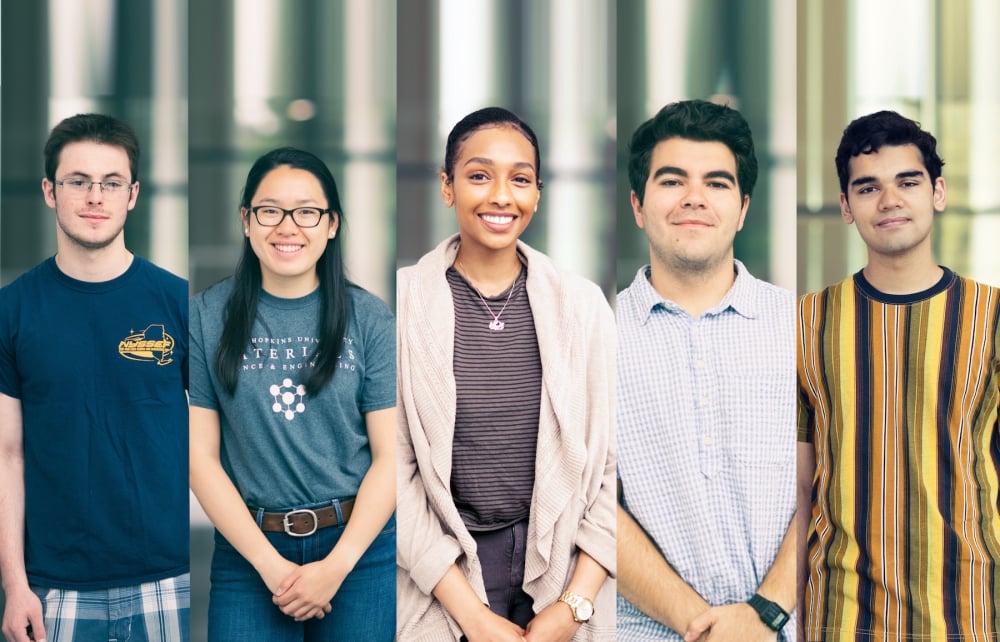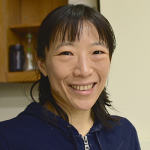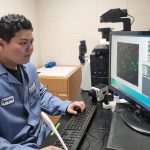A Summer of Science Abroad

As part of an international collaboration between Johns Hopkins University (JHU) and imec, each year 3 to 5 JHU students spend their summer in imec’s labs working on joint research projects.
(The photo above showcases the 2018 IRES student interns. From left to right: Ariel Slepyan, Jaynie Criscione, Rayyan Gorashi, Dante Navarro, and Ayon Mitra. Photo copyright imec)
Joining forces
“Imec was already established in silicon nanotechnology research and looking to expand their work into health and medical fields. It was decided that research collaborations would be kicked off with JHU’s newly founded Institute for NanoBioTechnology (INBT),” says Tom Fekete, director of corporate partnerships at INBT. INBT’s mission brings JHU experts in nanoscience, engineering and medicine together to tackle challenges in healthcare. The institute forms the bridge between nanotechnology and medicine in JHU and is therefore an ideal stepping stone for a collaboration.
Peter Searson, principal investigator for the IRES program and co-founder of INBT: “Imec and INBT explored several ideas for collaboration and the International Research Experience for Students (IRES) program seemed like a great starting point. IRES is a program funded by the National Science Foundation (NSF) and is meant to provide an international research and cultural experience for American undergraduate and graduate students. However, we wanted to push the program further and we added another layer by having students work on projects of mutual interest.”
Since the program started in 2009, INBT has been sending students every summer to work on microelectronics and nanoelectronics primarily in imec’s life science department. Liesbet Lagae, co-founder and program director of Life Science Technologies in imec: “It was clear from the beginning that if imec wanted to get a foothold in the domain of life sciences, they needed a partnership with a premier medical institution. The student program was a very concrete way of accomplishing that with a win-win for both parties: INBT students are granted access to imec’s infrastructure and technology, while imec receives top students that have a clear medical application in mind.”
An international experience…
Peter Searson: “The first important aspect is to provide students with an international experience since science, technology, engineering, and mathematics (STEM) research has and continues to become an increasing global community. Having work experience outside the US is incredibly helpful to grow as a researcher and have a successful career. Imec is a large international hub for researchers, students, and residents that maximizes the students’ exposure to the multi-cultural community and experience.”
Tom Fekete: “The broader objective of the program is to provide outstanding students an oversees opportunity in research and cultural immersion. What makes the program unique is that we have made it very research focused. At the same time, the program builds and strengthens the scientific relationships between INBT and imec and opens the door for future opportunities.”
Liesbet Lagae: “For us, it is a way to expose ourselves to the current research climate in the American biomedical research groups. We already maintain close relationships with the European medical institutes and are in daily contact with the University Hospital in Leuven. Johns Hopkins is the ideal medical connection to also stay in touch with trends in the American medical world.”
… and so much more
Tom Fekete: “Students get an incredible experience because imec is truly a world-class research and translational organization. It also has a phenomenal atmosphere with topic experts in many fields that run incredibly successful projects. Everyone takes the student projects very seriously and students benefit from dual mentoring with imec and Hopkins experts. They have left the program with more confidence about their skills and knowledge, and a new network of international contacts as they grow as researchers. Additionally, we receive feedback from imec that Hopkins students are independent, have great lab skills, and are self-motivated. Since imec receives students from all over the world, this is incredible to hear and lets INBT know that we are properly preparing students for successful careers.”
Peter Searson: “There are also small components to the program that contribute to the students’ training. For example, students practice different aspects of communication, by contributing to weekly group meetings with their imec team and during the final internship presentation in front of imec’s entire life science division and at INBT. They also write blogs about their experience and in this aspect, they learn how to use social media in a professional way.”
Liesbet Lagae: “Not only the JHU students but also the imec students learn from the summer program by getting exposure to American working practices. One of the most striking examples is that US students are fantastic presenters. They have been trained their whole life to communicate their research in a clear way. Maybe we should prepare students in Belgium in a similar way? Undoubtedly, they learn a lot by observing their American colleagues. It is these differences in the way research is performed and in scientific culture that makes the program an added value for each student, but just as much so for the supervisors.
A fruitful collaboration
Tom Fekete: “One of the most notable collaborations, resulting from the initial approaches through the student program, is a collaborative venture called miDiagnostics between imec and JHU. It combines the technical nanoelectronics expertise at imec with medical research at JHU to create accurate integrated diagnostic devices that enable faster and more efficient healthcare at any point of need. There have also been a number of scientific publications and posters created, along with a few patent applications. We have had successful ongoing relationships with imec and INBT labs such as David Gracias and Peter Searson.”
Liesbet Lagae: “A good relationship with a JHU promoter is vital for valorizing the summer research. Most students are still inexperienced in writing papers. We can help with that, but not without strong support from the American supervisors to write up a complete and coherent story. It was always part of the plan to be more than just a summer program. This is also a program in which supervisors on both sides line up about joint medical or technological projects that would not be feasible otherwise.
A nice illustration of a successful collaboration is a joint project on cancer cells. The Konstantopoulos lab at INBT investigates cancer cell movement in confined microenvironments. However, to image the cell’s movement required the use of sophisticated, albeit, expensive and complex, imaging methods. At the same time, imec was creating a compact, lens-free microscope system that fits inside an incubator to track cell movement in real-time. By adding an inexpensive, robust technical solution to a clinical problem, JHU’s experiments could be performed with increased throughput. At the end of the project, students from both institutions published their results in a paper supported by JHU and imec supervisors. Moreover, the lens-free imaging technique that was validated in the framework of the summer internships is now also used in miDiagnostics.”
The summer internships 2.0
Peter Searson: “Every year we do an exit interview with students and talk with our imec contacts, so there are always minor changes we make to ensure everyone has an enriching experience.”
Tom Fekete: “There are no major plans to alter the internship program, but we would like to have more students and researchers from imec do research and collaborate at INBT. In the past, we already welcomed a few imec PhD researchers to work at INBT under dual supervision. We are also exploring other collaborative research and translational opportunities with imec. With a mutual interest in healthcare, there is a logical collaboration in these areas.”
Liesbet Lagae: “It is still a dream to expand our program beyond the research collaboration and couple it to industry. A collaboration with industrial partners could not only improve future job opportunities for the students, but also allow working on industrially relevant problems and possibly facilitate valorization and uptake afterwards. We still do not have a concrete plan for implementation of such a collaboration yet. One of the possibilities is an industrial mentorship or sponsorship. With a broader base of funds, next to the NSF sponsoring, we could organize more joint projects and mature the existing ones. The question of how to organize such an industrial collaboration in practice will be a challenge for the new organizational team.”
The existing program will continue for the following summers, albeit, with a new team organizing the internship on both sides. Tom Fekete handed over the reins after his retirement to INBT’s new director of corporate partnerships, Luke Thorstenson. He will continue with the summer program on JHU’s and INBT’s side, together with Peter Searson. On imec’s side, Liesbet Lagae has passed on the baton to R&D manager of Life Sciences Dries Braeken.
Want to know more?
- Read about the research and cultural experiences of current and past summer interns at imec at INBT’s IRES program student blog.
- The IRES Program (International Research Experience for Students) is a 10-week program, funded by the National Science Foundation, that immerses students in a global research community. More about INBT’s NSF-funded IRES program, here.
- To read the papers resulting from the collaboration between imec and INBT (the paper about the metastasis assay with the lens-free microscope (Konstantopoulos lab), and the results from the projects together with the Gracias and Searson lab), fill out this form.
(This article originally appeared on July 5th, 2018 for the July issue of imec magazine. Read the full article, which includes biographies on Tom, Peter, and Liesbet, along with interviews of the 2018 student fellows. The original article is also available in Dutch.)





